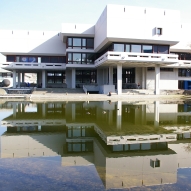Zusammenfassung
Reactions between the 1,3-diphosphete complex [Cp''' Co(h 4-P(2)C(2)tBu(2))] (1) and Ag[Al{OC(CF3)(3)}(4)] (Ag[pftb]) were carried out under different conditions. In CH2Cl2, the unprecedented 1,2-diphosphete isomerization product [Ag-2{Cp'''Co(mu,eta(4):eta(1):eta(1)-1,2-P(2)C(2)tBu(2))}(2){Cp'''Co(mu,eta(4):eta(1)-1,2-P(2)C(2)tBu(2))}(2)]center dot 2[pftb] (2) could be isolated. In diffusion ...
Zusammenfassung
Reactions between the 1,3-diphosphete complex [Cp''' Co(h 4-P(2)C(2)tBu(2))] (1) and Ag[Al{OC(CF3)(3)}(4)] (Ag[pftb]) were carried out under different conditions. In CH2Cl2, the unprecedented 1,2-diphosphete isomerization product [Ag-2{Cp'''Co(mu,eta(4):eta(1):eta(1)-1,2-P(2)C(2)tBu(2))}(2){Cp'''Co(mu,eta(4):eta(1)-1,2-P(2)C(2)tBu(2))}(2)]center dot 2[pftb] (2) could be isolated. In diffusion experiments of 1 in n-hexane with Ag[pftb] in CH2Cl2, the triphosphacobaltocenium complex [Cp'''Co(eta(5)-P(3)C(2)tBu(2))][pftb] (4) and the phosphirenylium complex [Cp'''Co(eta(3)-PC(2)tBu(2))][pftb] (5) were obtained, showing a ring expansion and a ring contraction, respectively, under mild conditions. Moreover, addition of pyridine to the Ag complex 2 led to the new 1,2-diphosphete complex [Cp'''Co(eta(4)-1,2-P(2)C(2)tBu(2))] (3). Compound 3 is also formed by thermolysis of 1, making it a promising method for this type of isomerization. 1,2-Diphosphete complexes like 3 are thermodynamically more stable but also synthetically more elusive than their 1,3-isomer counterparts.





 Altmetric
Altmetric